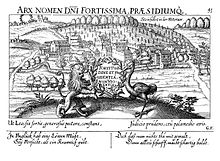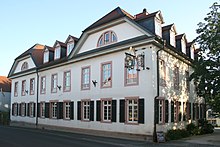Löw von Steinfurth

The Löw von Steinfurth (also Löw von und zu Steinfurth , more rarely Löw zu Steinfurth ) are an aristocratic family originally from the Middle Rhine , today Hessian , who are mainly based in the Wetterau .




history
The Löw von Steinfurth family is a very old lower nobility. The earliest naming of an Erwinus dictur Leo de Stenford comes from the year 1301. In the earliest sources, a closeness to the Lords of Kransberg is clear, with whom the Löw von Steinfurth shared the crane coat of arms and at this time also the lead name Erwin. The Lords of Kransberg died out in 1326, but had already sold their property around Kransberg Castle near Usingen to the Falkensteiners in 1310 . Another parallel can be seen in Löw's possession in Kransberg , from which Erwin Löw assigned ten florins to the Count Palatine in 1378 for the acquisition of the castle team at Lindenfels Castle .
In 1311 the family's property in Steinfurth was first mentioned as a court loan. The early family ownership thus probably had two regional focuses. The Löw von Steinfurth belong to the numerous servants who were tied to the king and whose origins can be traced back to the Hohenstaufen household property policy in the Wetterau after the Count of Nürings died out .
With the formation of larger territorial rulers in the late Middle Ages, these lower nobility united in the Middle Rhine Imperial Knighthood and the Burgraviate of Friedberg in order to maintain their independence. Between 1473 and 1806 the Löw von Steinfurth made up by far the most members of the Friedberg Burgmannen with 30, plus a total of five (together with the Kransbergers even seven) Burggraves. In addition to the properties as Friedberger Burglehen, fiefs came from various larger rulers, initially the Lords of Falkenstein and their successors, the Lords of Eppstein , Kurmainz , Fulda Abbey , Kurpfalz , Isenburg-Büdingen County and Hanau County . Two commander of the Teutonic Order can be traced in 1357 and 1459 on the Schiffenberg and in Prozelten .
In 1405 the Löw von Steinfurth were able to add another focus to their property by acquiring a share in the Staden inheritance around Staden Castle near Florstadt . At the beginning, this consisted of four parts and 19 partners, which were greatly reduced over time, because when a family died out in the male line, ownership fell back to the inheritance as a whole. In 1806 the inheritance was merged into three partners: Friedberg Castle 12/57, Grafschaft Isenburg 13/57 and Freiherren Löw von Steinfurth with 32/57. The places of Ober-Florstadt , Nieder-Florstadt and Stammheim belonged to the inheritance , the associated judicial district also included other places.
A family contract from 1537 initially determined the undivided succession in the male line. Since the 18th century, as with all imperial knighthood families, the title baron was customary, the family was formally elevated to this status in 1680. In 1710 a division was carried out: the older line kept its headquarters in Steinfurth, the younger one resided in Staden, went to Wiesbaden after the castle there was sold and did not return to Steinfurth until 1957. During the Napoleonic era, the Löw von Steinfurth lost their immediate imperial position and sovereignty fell to the Grand Duchy of Hesse . They were put on an equal footing with the Hessian aristocracy and became gentlemen of the state of Hesse and Darmstadt. Since the 19th century, numerous family members have been in the service of the grand ducal as court masters and chamberlain.
coat of arms
A silver crane on a blue background . The coat of arms is usually sprinkled with seven dagger-like, golden crosses. As a crest , the same crane used between an open, sprinkled with blue and gold crosses flight , the helmet covers are blue and gold. Occasionally two lions appear as shield holders. The coat of arms exists in numerous variants, the crane walks both to the left and to the right, his leg is not always raised. The crosses are sometimes depicted as real daggers. A lion's head in the upper right or a stone in the crane's claw are free additions to make the coat of arms “ speaking ”.
Historical possession
- Place Steinfurth , first half as a fiefdom of the Counts of Nassau-Saarbrücken , since 1430 the whole village. There was also a mill as an Isenburg fiefdom. The headquarters were also located in Steinfurth, initially a larger aristocratic court, and later the Löw Castle . A larger courtyard with a permanent house can be seen in a view of the Thesaurus philopoliticus in 1624 . The picture also shows an allegory of the Löw family with the lion and the crane in the foreground.
- Share in the inheritance of Staden with Staden Castle . In 1746 the family had a contemporary castle built here, the Löw'sche Schloss . In 1872 a large landscape park was created for this purpose.
- Löw'sches Schloss in Nieder-Florstadt, built by Franz Carl August Löw von und zu Steinfurth.
- Castle fiefdom in the Reichsburg Friedberg , Burgmannenhaus in the northwestern part of the castle, family coat of arms at St. Georgsbrunnen .
- as early as 1302, property in Echzell can be understood as a fuldisches fief. Between 1380 and 1491, there are further fiefdoms in Schwalheim and Bingenheim . In the Bingenheimer Burg as the center of the Fulda Mark , relatives are recorded as castle men in the years 1382, 1425 and 1453.
- Noteworthy is the participation of two Löw von Steinfurth in the inheritance of Tannenberg Castle in 1382. In 1399 the castle was besieged and destroyed by a coalition of towns and princes because of violations of the rural peace. However, there is no evidence of involvement in the year 1399 for the Löw von Steinfurth.
- In 1448 Sibold Löw von Steinfurth was appointed Burgmann in Büdingen . In the 15th century there are more castle men from the family.
- As a Hanau fiefdom, Eberhard Löw received the tithe at Fauerbach vor der Höhe , Ober-Straßheim and Burglehen in Munzenberg Castle in 1458 ; 1472 Sibold Löw is a Hanau castle man in Gelnhausen .
- In 1378 a Löw von Steinfurth was in the service of the Electorate of the Palatinate as a Burgmann at Lindenfels Castle .
In the domain of the family, the Solms land law became common law. The background to this was that the surrounding territories also adopted this "modern" law from 1571, which was recorded systematically and in writing and which also came from the immediate vicinity. The Common Law was now considered only when the Solmser land law contained no provisions for a fact. The Solmser Landrecht remained valid law in the Grand Duchy of Hesse , which was only replaced on January 1, 1900 by the civil code valid throughout the German Empire .
Relatives
- Eberhard Löw von Steinfurth (the elder), Friedberger Burggraf 1385–1405
- Eberhard Löw von Steinfurth (d. J.), Friedberger Burggraf (1407–1445)
- Ludwig Löw von Steinfurth, Friedberger Burggraf (1526–1532)
- Konrad Löw von Steinfurth, Friedberger Burggraf (1617–1632)
- Lothar Franz Löw von Steinfurth (1671–1735), Hessen-Kassel Brigadier
- Johann Löw von und zu Steinfurth, Friedberger Burggraf (1706–1710)
- Hugo Löw von und zu Steinfurt , Prussian district administrator in the Hadersleben district (1914–1920)
- Johann Hugo Wilhelm, Freiherr Löw von und zu Steinfurth (1750–1786), royal. Prussian Chamberlain and Knight of the Joseph Order
- Siegmund Löw von und zu Steinfurth (1757–1846), general in English and royal Hanoverian services
- Erwin Löw von und zu Steinfurth (1841–1914), Hessian chamberlain, district administrator and member of the German Reichstag
- Ludwig Löw von und zu Steinfurth (President of the Court) (1803–1868), German legal scholar, university professor and judge
- Ludwig Löw von und zu Steinfurth (engineer) (1875–1939), German engineer and university professor
- August von Löw zu Steinfurth (1819–1890), member of parliament
- Wilhelm von Löw zu Steinfurth (1805–1873), member of parliament
- Eberhard von und zu Steinfurth (1909–1993), lawyer and SS leader
literature
- Heinrich Bingemer: The Frankfurt coat of arms booklet. 2nd edition, Kramer, Frankfurt 1987, ISBN 3-7829-0348-X , p. 27, plate 19.
- Ernst Heinrich Kneschke : New general German noble lexicon , Volume 5, 1864; Reprint 1996, ISBN 3-89557-020-6 , pp. 618-620.
- Gerhard Köbler : Historical lexicon of the German countries. The German territories from the Middle Ages to the present. 7th, completely revised edition. CH Beck, Munich 2007, ISBN 978-3-406-54986-1 , p. 392.
- Reimer Stobbe: The Löw von Steinfurth. The story of the »Herrenhaus von Löw« in Steinfurth on the occasion of its restoration in 1994. Deutscher Sparkassenverlag, Stuttgart 1994, ISBN 3-09-303812-X
- Gothaisches genealogical pocket book of baronial houses, 1856, p.417ff
Individual evidence
- ↑ Ludwig Baur (Ed.): Hessian documents from the grand ducal Hessian house and state archives for the first time published, Volume 1: The provinces of Starkenburg and Upper Hesse from 1016 - 1399. Published 1860, No. 424.
- ^ Reimer Stobbe: Die Löw von Steinfurth. The story of the »Herrenhaus von Löw« in Steinfurth on the occasion of its restoration in 1994. Stuttgart 1994, p. 12f.
- ↑ Valentin Ferdinand Gudenus : Codex diplomaticus sive anecdotorum res Moguntinas, Francias, Treverensis, Coloniensis finitimarumque regionum nec non ius Germanicarum SRI historiam vel maxime illustrantium, Volume 3 , 1751, p. 67f., No. LIV.
- ^ Reimer Stobbe: Die Löw von Steinfurth. The story of the »Herrenhaus von Löw« in Steinfurth on the occasion of its restoration in 1994. Stuttgart 1994, p. 24f.
- ↑ Thomas Schilp: The Reichsburg Friedberg in the Middle Ages. Studies of their constitution, administration and politics. Bindernagel, Friedberg 1982, p. 170.
- ^ Reimer Stobbe: The history of Friedberg: From the foundation to the Reformation time. In: Michael Keller (Ed.): Friedberg in Hessen. The history of the city. Volume I. From the beginnings to the Reformation. Bindernagel, Friedberg 1997, pp. 195f .; Reimer Stobbe: The Löw von Steinfurth. The story of the »Herrenhaus von Löw« in Steinfurth on the occasion of its restoration in 1994. Stuttgart 1994, pp. 21–24.
- ^ Reimer Stobbe: Die Löw von Steinfurth. The story of the »Herrenhaus von Löw« in Steinfurth on the occasion of its restoration in 1994. Stuttgart 1994, p. 16f.
- ↑ Arthur B. Schmidt: The historical foundations of civil law in the Grand Duchy of Hesse . Curt von Münchow, Giessen 1893, p. 106, as well as the enclosed map.

